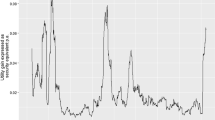Abstract
For those with constant relative-risk-aversion, one can calculate an easy and exact measurement of their risk-corrected total return per period by use of an appropriate "power mean". For them, this approach can dramatize the inefficiency of being (say) half the time in each of two independent and identically distributed securities; 100% is then lost of the benefit from being all the time 50-50 in each; actually, being half the time in each is as bad as being all the time in either one, which is equivalent to being completely undiversified. More generally, there is proved here that, for any risk-averse U(W) and time-independent probabilities, optimal diversification within each time period outperforms generically any and all patterns of across-time diversification. The variety of proposed risk-corrected returns can give useful approximations for different classes of investors–widows and orphans, pension fiduciaries, high-flying plungers, and so forth–to replace or extend Markowitz, Sharpe, Treynor, or Modigliani-Modigliani measures of corrected performance.
Similar content being viewed by others
References
Arrow, Kenneth J., Hollis A. Chenery, Bagicha S. Minha, and Robert M. Solow. (1961). “Capital-Labor Substitution and Economic Efficiency,” Review of Economics and Statistics August, 225–250.
Chow, Gregory. (1993). “Optimal Control Without Solving the Bellman Equation,” Journal of Economic Dynamics and Control 17, 621–630.
Jensen, Michael E. (1968). “The Performance of Mutual Funds in the Period 1945–1964,” Journal of Finance May,–.
Machina, Mark. (1982). “‘Expected Utility’ Analysis Without the Independence Axiom,” Econometrica 50, 277–323.
Modigliani, Franco, and Leah Modigliani. (1996). “The Modigliani-Modigliani Measure of Risk Adjusted Performance (MAP).” Paper presented at the Financial Economists Roundtable, Newport, RI, July 8, 1996.
Samuelson, Paul A. (1989). “The Judgment of Economic Science on Rational Portfolio Management: Indexing, Timing, and Long-Horizon Effect,” Journal of Portfolio ManagementFall, 4–12.
Samuelson, Paul A. (1990). “Asset Allocation Could Be Dangerous to Your Health: Pitfalls in Across-Time Diversification,” Journal of Portfolio ManagementSpring, 5–8.
Samuelson, Paul A. (1996). “The Irreducible Role of Derived Marginal Utility in Dynamic Stochastic Programming,” Pacific Economic Review 1, 3–11.
Sharpe, William F. (1966). “Mutual Fund Performance,” Journal of Business, Supplement on Security Prices 39, 119–138.
Treynor, Jack L. (1996). “How to Rate Management Investment Funds,” Harvard Business Review January–February, 43.
Author information
Authors and Affiliations
Rights and permissions
About this article
Cite this article
SAMUELSON, P. Proof by Certainty Equivalents That Diversification-Across-Time Does Worse, Risk Corrected, Than Diversification-Throughout-Time. Journal of Risk and Uncertainty 14, 129–142 (1997). https://doi.org/10.1023/A:1007773311522
Issue Date:
DOI: https://doi.org/10.1023/A:1007773311522




